|
|
|
LA PÉROUSE (Jean-François de Galaup, comte de).
[MONTEREY] Plan de la baie de Monterey située dans la Californie septentrionale.
[Paris, 1797]. 334 x 490 mm.
Riferimento per il libraio : LBW-2787

|
|
|
LA HARPE Jean-François de:
Abrégé de l'histoire générale des voyages, contenant ce qu'il y a de plus remarquable, de plus utile & de mieux avéré dans les pays ou les voyageurs ont pénétré; les moeurs des habitans, la religion, les usages, arts & sciences commerce, manufactures; enrichi de cartes géographiques & de figures.
Paris, Hôtel de Thou [et] Laporte, 1780 [et] 1786. 23 volumes in-8 et un volume in-4 pour l'atlas. Plein veau raciné brun, dos lisses ornés de filets et fleurons dorés, pièces de titre et tomaison en maroquin rouge. Accident de vers aux volumes 18 et 22, et une tache aux derniers feuillets du vol. 12. Menus défauts à quelques coiffes et quelques coins frottés.
Riferimento per il libraio : 15445
|
|
|
LA PÉROUSE (Jean-François de Galaup, comte de).
Carte du Grand Océan ou Mer du Sud.
[Paris, 1797]. 510 x 699 mm.
Riferimento per il libraio : LBW-2785
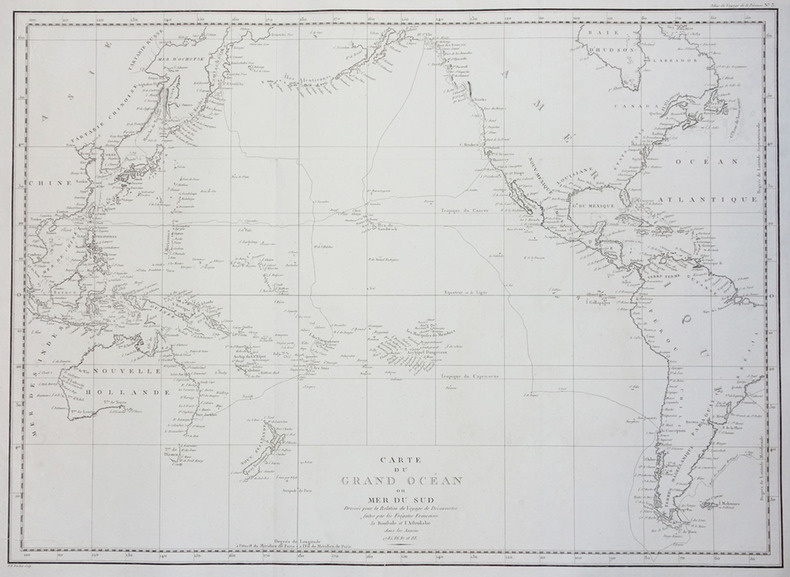
|
|
|
LA PÉROUSE (Jean-François de Galaup, comte de).
Carte générale d'une partie de la côte du nord-ouest de l'Amérique.
[Paris, 1797]. 684 x 492 mm.
Riferimento per il libraio : LBW-3733
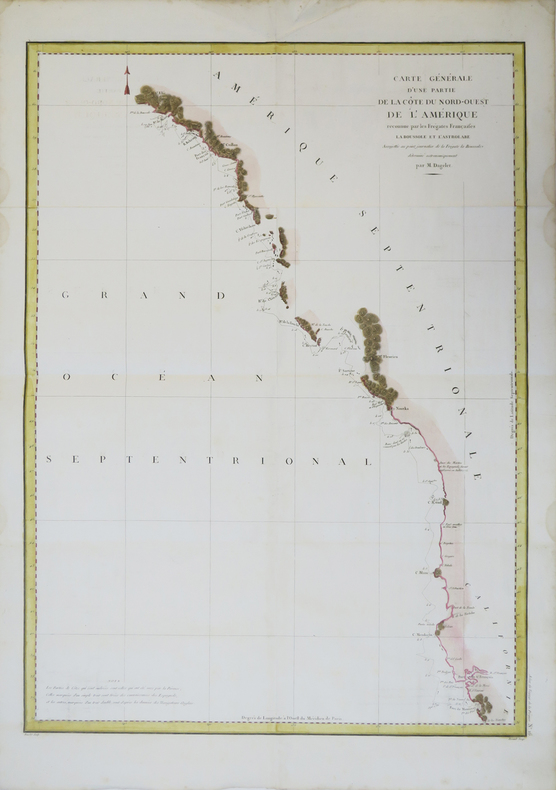
|
|
|
LA PÉROUSE (Jean-François de Galaup, comte de).
Carte générale des découvertes faites en 1787 dans les mers de Chine et de Tartarie, ou depuis Manille jusqu'à Avatscha, par les frégates françaises la Boussole et l'Astrolabe.
[Paris, 1797]. 683 x 493 mm.
Riferimento per il libraio : LBW-6247
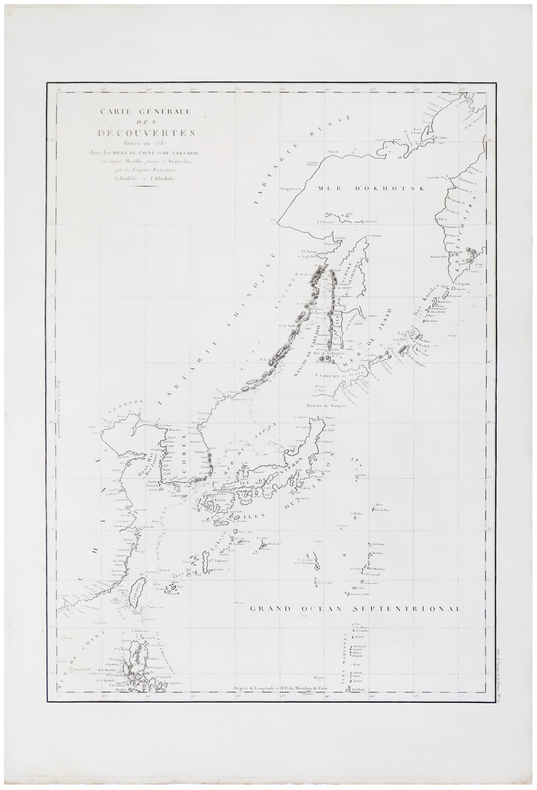
|
|
|
LA BEDOLLIERE (Emile de)
Fontainebleau, carte topographique couleurs sur double page dessinée et gravée par EHRARD, tirée de l'Histoire des environs du nouveau Paris.
1861 Edité par Paris, Gustave Barba, [s.d., 1861], 1861,pli central,bon état.
Riferimento per il libraio : 27435
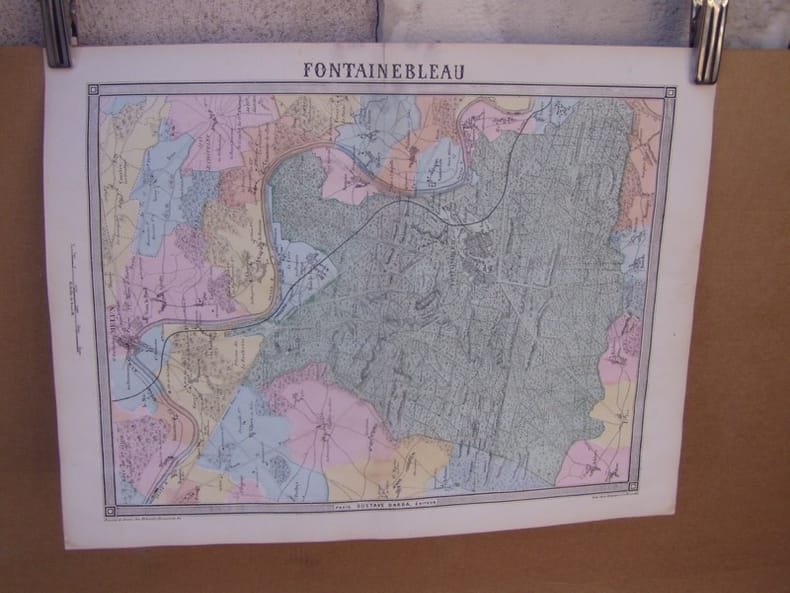
|
|
|
LA VARENDE, Jean de (Texte, Cartes établies par) - Dessins réalisés par G. MARJOLLIN
Guillaume le Batard Conquérant
Maximilien Vox/Union bibliophile de France - 1946 - Première edition - In-8 - broché - couverture illustrée - Frontispice gravé sur bois par Blaise MONOD - Illustrations en texte - 263 pages + Table des illustrations - Hors-texte de P. Le Trividic - Exemplaire non coupé, bon état
Riferimento per il libraio : 24271
|
|
|
LA POUPÉE MODÈLE.
Jeu du Pôle Nord - Supplément au N° du 15 décembre 1909 de La Poupée Modèle.
Paris, La Poupée Modèle, 1909. 499 x 637 mm ; monté sur carton.
Riferimento per il libraio : LBW-8545

|
|
|
LA CONDAMINE (Charles-Marie de)
Journal du voyage fait par ordre du Roi à l'Equateur servant d'Introduction historique à la mesure des trois premiers degrés du Méridien
Paris, Imprimerie Royale, 1751. In-4, veau marbré, dos à nerfs orné avec pièce de titre, filets aux plats, XXXvj +280 pages + XV pages - illustré de deux cartes dépliantes, quatre planches dont trois dépliantes et un tableau dépliant. Reliure avec usures, quelques épidermures, mors avec fentes et frottements, coins émoussés, quelques taches et piqures éparses, déchirure à la carte pliante de la Province de Quito au Pérou sinon bon état intérieur
Riferimento per il libraio : PHO-1682

|
|
|
LA CONDAMINE (Charles-Marie de).
Journal du voyage fait par ordre du Roi, a l'Équateur, servant d'introduction historique à la Mesure des trois premiers degrés du Méridien. Paris, Imprimerie Royale, 1751. In-4 de (2)-xxxvi-280-xv pp., 2 cartes et 5 planches hors texte repliées. LA CONDAMINE (Charles Marie de). Mesure des trois premiers degrés du Méridien dans l'Hémisphère austral, tirée des observations de MM. de l'Académie royale des sciences, envoyés par le roi sous l'Équateur, par M. de La Condamine.
Paris, Imprimerie Royale, 1751. In-4 de (12)-266-X-VIII pp., 3 planches hors texte dont 2 dépliantes.Les deux pièces reliées en 1 vol. in-4, veau marbré, dos orné à nerfs, pièce de titre en maroquin rouge, triple filet doré d'encadrement sur les plats, tranches dorées sur marbrure (reliure de l'époque).
Riferimento per il libraio : 42132
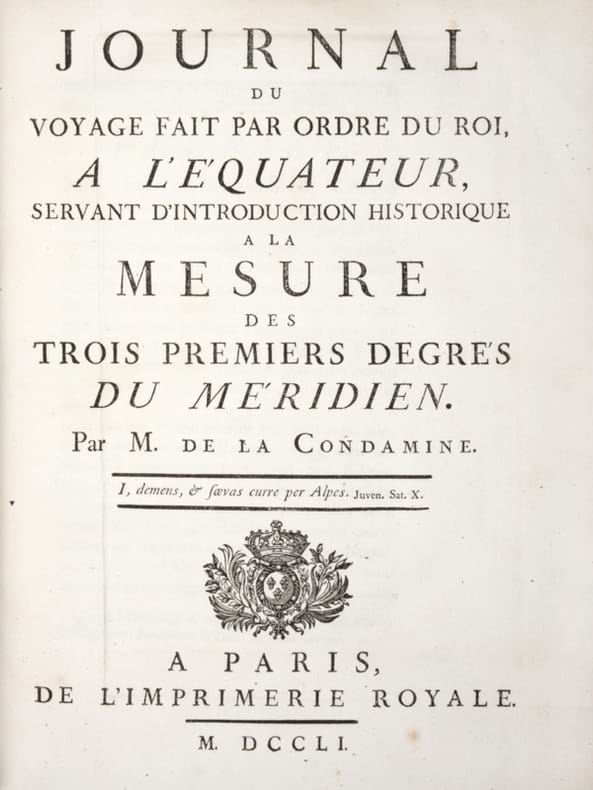
|
|
|
LA ROCHELLE. MANUSCRIT.
La Rochelle.
[circa 1700]. 420 x 525 mm.
Riferimento per il libraio : LBW-4178
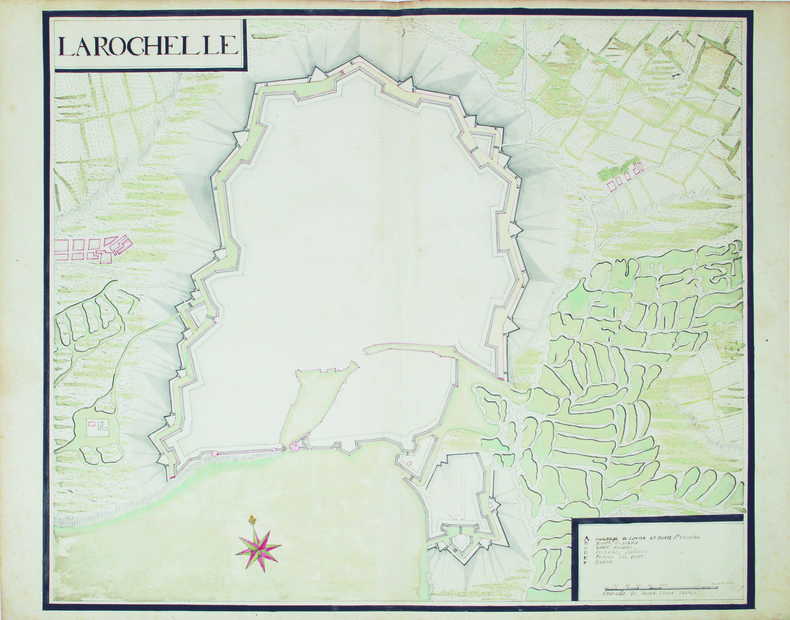
|
|
|
LA PETITE ILLUSTRATION : THEATRE Publicité Michelin en 4e de couverture : les cartes Michelin. Seules, les cartes Michelin indiquent …
La Petite illustration théâtrale N° 6 : Le destin est maître, pièce de Paul Hervieu.
Couverture souple. Revue. 20 pages.
Riferimento per il libraio : 31185

|
|
|
LA PETITE ILLUSTRATION : THEATRE Publicité Michelin en 4e de couverture : les cartes Michelin. Seules, les cartes Michelin indiquent …
La Petite illustration théâtrale N° 6 : Le destin est maître, pièce de Paul Hervieu.
Couverture souple. Revue. 20 pages.
Riferimento per il libraio : 44949

|
|
|
LA PETITE ILLUSTRATION : THEATRE Publicité Michelin en 4e de couverture : les cartes Michelin. Seules, les cartes Michelin indiquent …
La Petite illustration théâtrale N° 6 : Le destin est maître, pièce de Paul Hervieu.
Couverture souple. Revue. 20 pages.
Riferimento per il libraio : 106593

|
|
|
LA BIBLE - SEGOND Louis 4 cartes en couleurs.
La Bible qui comprend l'ancien et le nouveau testament traduits d'après les textes originaux hébreu et grec.
Couverture rigide. Reliure rouge. Environ 1000 pages.
Riferimento per il libraio : 143576

|
|
|
La revue d’infanterie - Ministère de la guerre / ed. Charles-Lavauzelle &Cie; éditeurs militaires
La revue d’infanterie Chronique des régiments : les fêtes du 3e régiment d’infanterie alpine, par les lieutenants de reserve Pouzin, Simonnet, Yvernès / Réflexions sur le travail en liaison, par le lieutenant-colonel d’artillerie Gaston Marie / Etude raisonnée d’une situation tactique, par le colonel Colin / Les renseignements de contact dans l’offensive : étude dans le cadre d’un cas concret historique, par le commandant Carrias . . . Revue illustrée de plusieurs cartes et photographies dépliables
N° 529 (89e volume) de 01 octobre 1936 - 45e année - revue illustrée - hors-texte - carte - in-8 Broché - 208 pages
Riferimento per il libraio : 9309
|
|
|
La revue d’infanterie - Ministère de la guerre / ed. Charles-Lavauzelle &Cie; éditeurs militaires
La revue d’infanterie Ficelles et gibernes, par le général Clément-Grandcourt / Un régiment d’infanterie allemand, par le colonel Besnier / On ne fera pas la guerre qu’en plein jour, par le lieutenant de réserve Toupance / Objectifs vivants pour exercices avec tir réel, par le lieutenant-colonel Paillé / Les renseignements de contact dans la défensive, par le commandant Carrias (suite) / Thèmes tactiques allemands (suite), par le commandant Quenot . . . Revue illustrée de plusieurs cartes et photographies dépliables
N° 530 (89e volume) de 01 novembre 1936 - 45e année - revue illustrée - hors-texte - carte - in-8 Broché - 190 pages
Riferimento per il libraio : 9310
|
|
|
La Table Ronde
La Table Ronde Une heureuse enfance ( Alain ) - Voyage sans cartes ( Graham Greene ) - Les quatre-vingt-dix-neuf ans de Paul Bourget ( François Mauriac ) - Espace et temps chez Joubert ( Georges Poulet ) - A travers les rues de Naples ( Roger Peyrefitte ) - La fenêtre ( I ) ( Mario Soldati )
N° 39 / Mars 1951 - in-8 broché - 184 pages
Riferimento per il libraio : 11303
|
|
|
LA RONCIERE Monique de - MOLLAT du JOURDIN Michel
Les portulans - Cartes marines du XIIIe au XVIIe siècle
Fribourg, Office du Livre, 1984, in-4 rel. toile (25 x 35), 295 p., 100 planches en coul., 23 ill. n. et b., jaquette, très bon état.
Riferimento per il libraio : QWA-17150
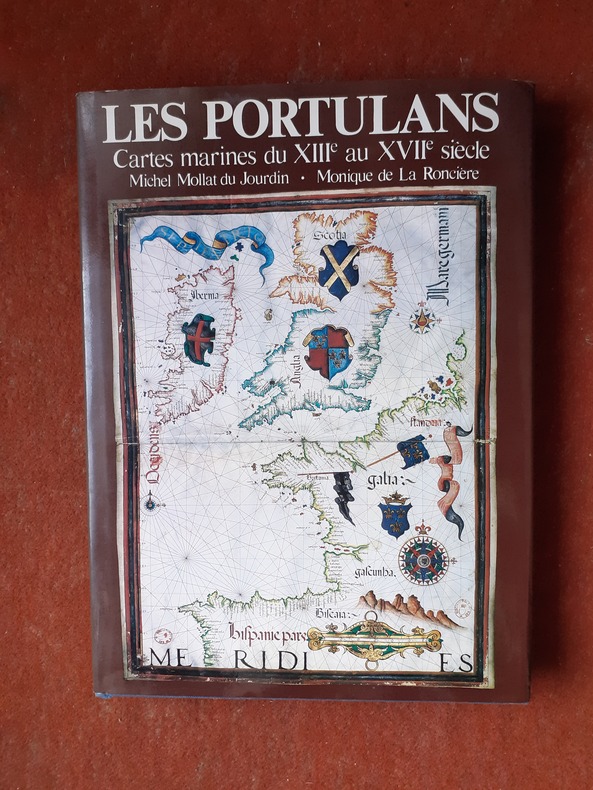
|
|
|
LA RONCIERE Monique de - MOLLAT du JOURDIN Michel
Les portulans - Cartes marines du XIIIe au XVIIe siècle
Fribourg, Office du Livre, 1984. in-4 rel. toile (25 x 35), 295 p., 100 planches en coul., 23 ill. n. et b., jaquette.
Riferimento per il libraio : MAR705M
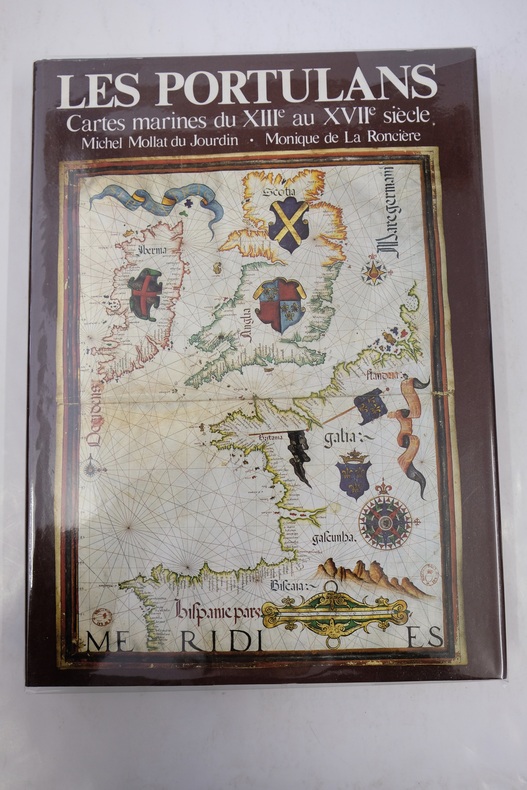
|
|
|
LA ROCHEJAQUELEIN Marquise de:
Mémoires de Mme la Marquise de Rochejaquelein, écrits par elle-même. Cinquième édition revue, corrigée et augmentée de différentes pièces, avec deux cartes et un portrait.
A Paris, De l’imprimerie Royale, 1822. In-8 de VII-495 pages, demi-basane brune, dos lisse orné, étiquette de titre noire. Mors du 1er plat fendu, coiffe supérieure manquante, manque en haut du dos, manque un coin, les autres frottés.
Riferimento per il libraio : 1786
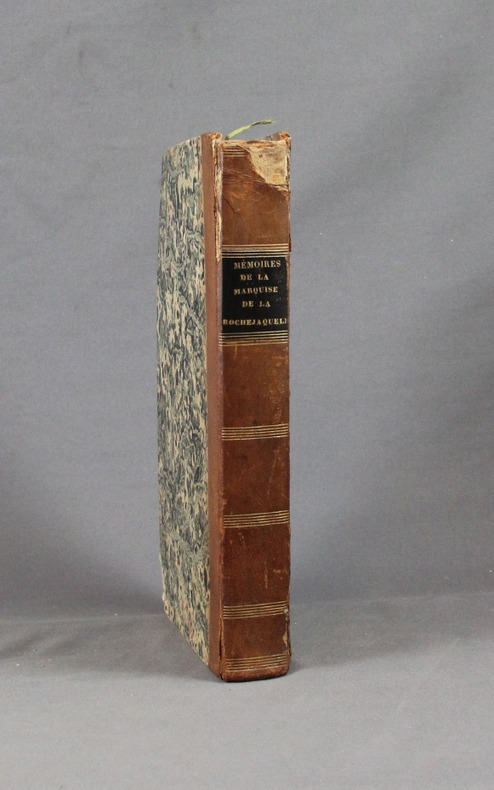
|
|
|
LA PÉROUSE (Jean-François de Galaup, comte de).
Perdrix, mâle et femelle, de la Californie.
[Paris, 1797]. 261 x 399 mm.
Riferimento per il libraio : LBW-458
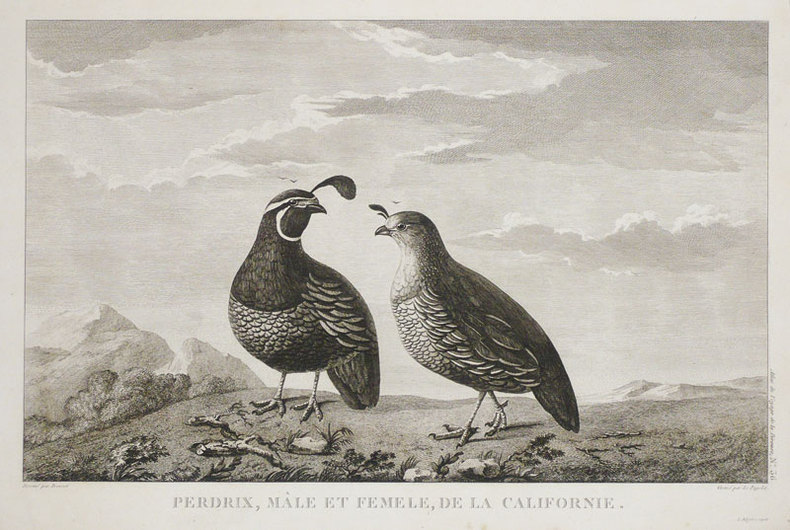
|
|
|
LA PÉROUSE (Jean-François de Galaup, comte de).
Plan de la baie de Monterey située dans la Californie septentrionale.
[Paris, 1797]. 334 x 490 mm.
Riferimento per il libraio : LBW-973
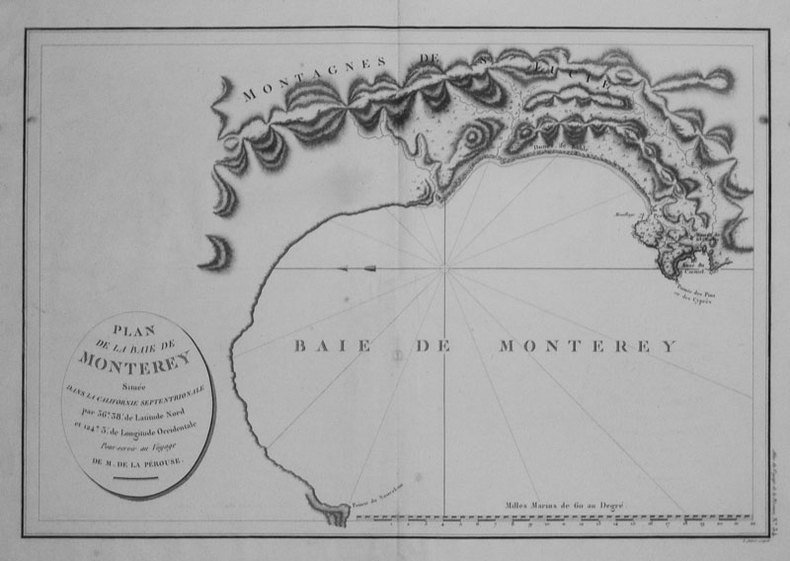
|
|
|
LA FAIRE (G. de).
Prise de la citadelle de Kinburn.
17 8bre [octobre] 1855 14,5 x 24 cm, sur une feuille de 21,5 x 43 cm pliée en deux.
Riferimento per il libraio : LBW-6611

|
|
|
LA PÉROUSE (Jean-François de Galaup, comte de).
Promerops de la Californie septentrionale.
[Paris, 1797]. 413 x 252 mm.
Riferimento per il libraio : LBW-836
|
|
|
LA CONDAMINE, Charles Marie de.
Relation abrégée d'un voyage fait dans l'intérieur de l'Amérique méridionale, depuis la côte de la mer du sud, jusqu'aux côtes du brésil et de la Guyane, en descendant la rivière des Amazones.
Maestricht, Jean-Edme Dufour & Philippe Roux, 1778. In-8°, pleine marge : [4]-xvi-379 pp.; 2 h.-t. , brochage d’attente, illustré d’une gravure et d’une carte les deux dépliantes, mouillures, Papier bruni.
Riferimento per il libraio : PHO-1745

|
|
|
LA RONCIERE, Monique de & MOLLAT DU JOURDIN, Michel:
Sea charts of the early explorers 13th to 17th century. In collaboration of Marie-Mad. Azard, Isabelle Raynaud-Nguyen and Marie-Ant. Vannerau. Translatet from French by L. le R. Dethan.
London, Thames & Hudson, 1984, gr. in-4°, 298 p., richly illustrated in colors, copy from the archives of the publisher stamped ‘‘Exemplaire d’Archive’, else fine. orig. clothbound, orig. colour jacket, slipcase. fine copy.
Riferimento per il libraio : 86313aaf
|
|
|
LA BEDOLLIERE (Emile de)
St-Germain,,carte topographique couleurs sur double page dessinée et gravées par EHRARD, tirée de l'Histoire des environs du nouveau Paris.
1861 Edité par Paris, Gustave Barba, [s.d., 1861], 1861,pli central,bon état.
Riferimento per il libraio : 27433

|
|
|
LA CONDAMINE, M. de
A Succinct Abridgment of a Voyage made within the Inland Parts of South America from the Coasts of the South Sea to the Coasts of Brazil & Guiana, down the River of Amazonas
8vo [22 x 13.5 cm]; xii, 108 pp, folding engraved map, with the half title page. contemporary marbled boards, leather spine, covers worn, joints repaired with leather, lacks front blank endpaper, map with old one inch tear repaired, interior is very good. A picture of this book is available upon request by email. Sabin 38488. A French-Spanish expedition was sent to South America in 1736, to measure a degree of latitude in the area near Quito where the equator crossed, to determine the size and shape of the earth. The ten year expedition proved that the earth is flattened at the Poles. La Condamine returned by crossing Brazil via the Amazon. His narrative of his journey was of great importance, because for the first time the long course of the Amazon was traversed by a man of science capable of making astronomic observations, and determining longitudes.' [Borba de Moraes, I, 447] The fine engraved map of the Amazon and its tributaries accompanying the text was drawn by La Condamine himself, and is the first map in which the latitudes were observed and shown on the map. Cox ii, 273: 'La Condamine returned to the east coast of the continent by descending the Amazon, the first time it was accomplished by a scientist'. Hill 169: 'the greatest geographical event of the eighteenth century as regards South America. . . to measure one exact degree of meridian to determine the dimensions and shape of the earth. . . the work occupied eight years'. Goodman 495: 'A very useful abridgment of this indispensible work, entirely satisfactory for nearly all purposes'. Spain & Spanish America I, 369.
|
|
|
LA CONDAMINE, M. de
A Succinct Abridgment of a Voyage made within the Inland Parts of South America from the Coasts of the South Sea to the Coasts of Brazil & Guiana, down the River of Amazonas
8vo [21x 13 cm]; xii, 108 pp, folding engraved map, with the half title page. contemporary full leather, spine worn, joints repaired, light foxing including on map, but mostly marginal, internally clean and very good. A picture of this book is available upon request by email. Sabin 38488. A French-Spanish expedition was sent to South America in 1736, to measure the degree of latitude in the area near Quito where the equator crossed, to determine the size and shape of the earth. The ten year expedition proved that the earth is flattened at the Poles. La Condamine returned by crossing Brazil via the Amazon. His narrative of his journey was of great importance, because, for the first time, the long course of the Amazon was traversed by a man of science capable of making astronomic observations, and determining longitudes.' [Borba de Moraes, I, 447] The fine engraved map of the Amazon and its tributaries accompanying the text was drawn by La Condamine himself, and is the first map in which the latitudes were observed and shown on the map. Cox ii, 273: 'La Condamine returned to the east coast of the continent by descending the Amazon, the first time it was accomplished by a scientist'. Hill 169: 'the greatest geographical event of the eighteenth century as regards South America. . . to measure one exact degree of meridian to determine the dimensions and shape of the earth. . . the work occupied eight years'. Goodman 495: 'A very useful abridgment of this indispensable work, entirely satisfactory for nearly all purposes'. Spain & Spanish America I, 369.
|
|
|
LA CONDAMINE, M. de
Relation Abregee D'un Voyage Fait Dans L'interieur De L'amerique Meridionale. Depuis La Cote De La Mer du Sud, Jusqu'aux Cotes du Bresil & De La Guiane, En Descendant La Riviere Des Amazones [Voyage made within the Inland Parts of South-America . . .]
8vo [20.5 x 13 cm]; xvi, 216, [iv, privege du roi] pp, folding engraved map, errata. contemporary full tree calf, gilt spine title lettering on leather label, gilt spine decorations, all edges gilted, marbled endpapers, corners and spine end worn, small inkstamp on title page, interior quite clean and fine, cover very good. A picture of t Sabin 38484. A French-Spanish expedition was sent to South America in 1736, to measure a degree of latitude in the area near Quito where the equator crossed, to determine the size and shape of the earth. The ten year expedition proved that the earth is flattened at the Poles. La Condamine returned by crossing Brazil via the Amazon. His narrative of his journey was of great importance, because for the first time the long course of the Amazon was traversed by a man of science capable of making astronomic observations, and determining longitudes.' [Borba de Moraes, I, 446] The fine engraved map of the Amazon and its tributaries accompanying the text was drawn by La Condamine himself, and is the first map in which the latitudes were observed and shown on the map. Cox ii, 272. Hill 168.
|
|
|
LA FERTE
Carte au 1/200 000e. Sans date.
Une feuille 32x50 cm.
|
|
|
LA GUERCHE
Carte couleur au 1/100 000?. Feuille IX-17. Mise ? jour 1923.
Une feuille 57x45 cm.
|
|
|
LA MARE Nicolas de COQUART A. & DE FER N.
Ensemble complet des plans de la ville de Paris tirés du Traité de la Police
- S.n., Paris 1705, reliure : 34,5x50cm ; cartes : 60x48,5cm et 61x48,5cm et 59x47cm et 60x48cm et 60x48cm et 61x48cm et 61x48,5cm et 57,5x47,5cm, montées sur onglets sous reliure. - Edition originale. Sept plans réalisés par Coquart et un par De Fer : - Lutèce ou premier plan de la ville de Paris - Lutèce conquise par les François sur les Romains - Troisième plan de la ville de Paris, son étendüe et les Bourgs dont elle étoit environnée sous le règne de Loüis le Ieune VIIème du nom - Quatrième plan de la ville de Paris, son accroissement et l'état ou elle êtoit sous le regne de Philippe Auguste - Cinquième plan de la ville de Paris, son accroissement et sa quatrième clôture commancée sous Charles V l'an 1367 et finie sous Charles VI l'an 1383 - Sixième plan de la ville de Paris, et ses accroissements, depuis le commencement du Règne de Charles VII l'an 1422 jusqu'a la fin du regne d'Henry III l'an 1589 - Septième plan de la ville de Paris, son acroissement et ses embelissemens sous Henry IIII et Louis XIII depuis 1589 jusqu'en 1643 - Huitième plan de Paris divisé en ses vingts quartiers. Reliure en plein cartonnage bleu moderne, dos lisse, étiquette ancienne conservée sur le premier plat. Quelques petites restaurations marginales au verso de certaines planches. Très bel ensemble. [ENGLISH DESCRIPTION ON DEMAND]

|
|
|
LABORATOIRES MARINIER - CARTES DE BLAEU
La France : Provinces. Reproductions de 30 cartes de Blaeu 1620-1680.
- Brochure de 24 pages. 15 x 23 cm. Légèrement défraîchie.
Riferimento per il libraio : 74419
|
|
|
LABOULAIS Isabelle (sous la direction de)
Les usages des cartes (XVIIe - XIXe siècle). Pour une approche pragmatique des productions cartographiques
Presses Universitaires de Strasbourg, 2008, 285 p., in-8 br., coll. "Sciences de l'Histoire", ouvrage publié dans le cadre du programme ANR HistCarto, 21 fig. in-t., 69 planches h.-t., jaquette, état de neuf
Riferimento per il libraio : QWA-5431
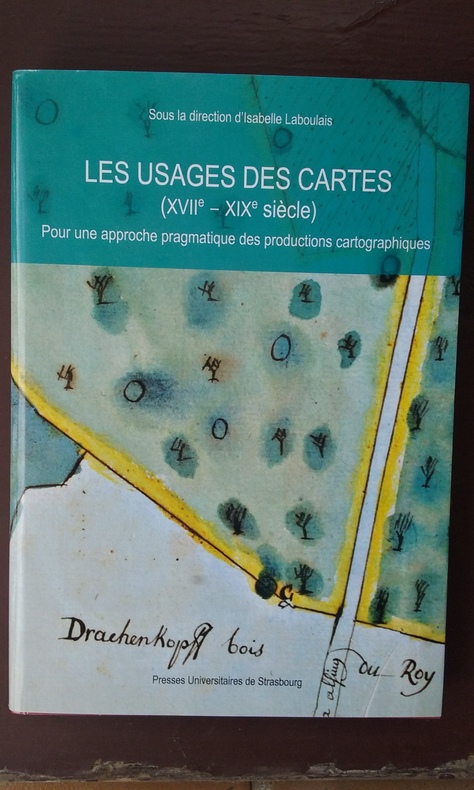
|
|
|
LABOURASSE H.
Petite géographie de la Meuse.
Précédée de notices ce géographie générale à l’usage des écoles primaires du département.Par H.LABOURASSE maître de pension.3ème édition revue et corrigée.In 16 cartonné, plats imprimés;dos demi toile bleue,Faux-titre,titre,142 pages,Saint-Mihiel 1859.Rousseurs habituelles.Description des cantons etc.Peu courant
Riferimento per il libraio : 5061
|
|
|
LABAUME (Eugène).
Relation circonstanciée de la Campagne de Russie, en 1812; ornée des plans de la bataille de la Moskwa, du combat de Malo-Jaroslavetz, … 4e édition.
Paris, C. L. F. Panckoucke et Magimel, février 1815. In-8, demi-basane fauve, dos lisse orné de filets dorés, pièce de titre basane rouge, tranches jaspées.
Riferimento per il libraio : PHO-1757

|
|
|
LABBE, Vincent.
Secret défense.
Editions Le bridgeur, 1994. Un volume in-8°, broché.
Riferimento per il libraio : 17332
|
|
|
LACOMBE, Benjamin
Il était une fois... (Pop-up, livre à système)
2010 Editions Seuil Jeunesse - 2010 - In-4, cartonnage illustré - 8 belles illustrations en couleurs en pop-up
Riferimento per il libraio : 119774

|
|
|
LACOMBE Robert
La chartreuse de Sainte-Croix (Loire) en vues et cartes postales anciennes
1983 Imprimerie Claude Bigot - 1983 - In-18 à l'italienne broché - 54 pages - nombreuses reproductions photograhiques
Riferimento per il libraio : 94856
|
|
|
LACROIX Louis
les écraseurs de crabes sur les derniers voiliers caboteurs.
Préface du capitaine A. MARCHAANDEAU. In 8 broché, couverture illustrée, faux-titre, titre, 348 pages, annexe XXXVI- illustrations photos hors-texte, 2 cartes dépliantes en fin de volume. Aux portes du large- Nantes 1947. Edition originale, envoi manuscrit autographe de l’auteur.
Riferimento per il libraio : 11770
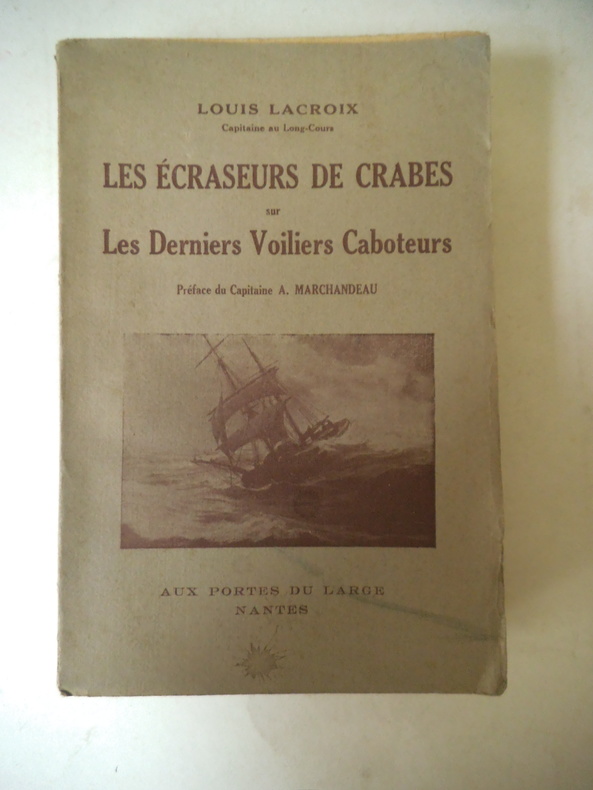
|
|
|
LACROIX Louis; MARCHANDEAU Capitaine A. (préf.):
Les écraseurs de crabes sur les Derniers Voiliers Caboteurs.
Nantes, Aux portes du large, 1947. In-8 broché de 348-XXXVI pages, couverture illustrée. Belle condition.
Riferimento per il libraio : 2380
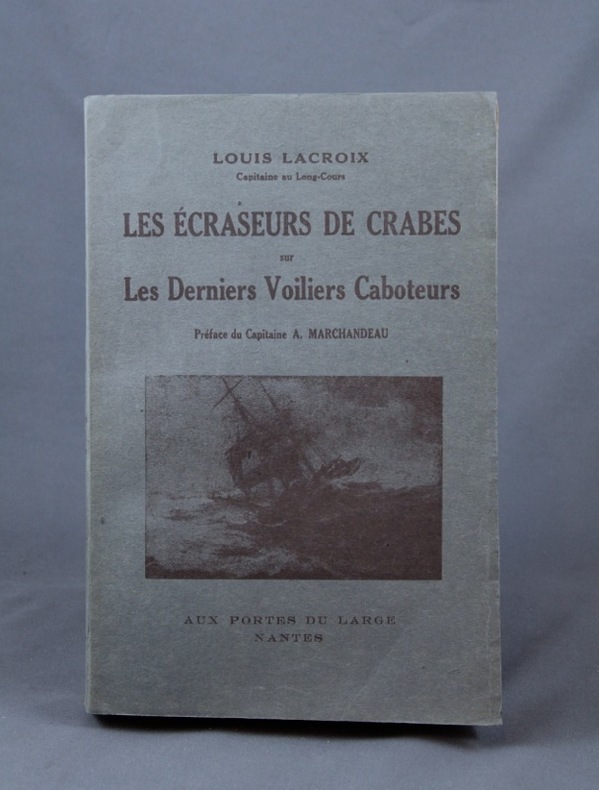
|
|
|
LACROIX Paul, Conservateur de la Bibliothèque National de l'Arsenal - (Pseudonyme "Bibliophile Jacob") .
LES ARTS AU MOYEN-AGE ET A L'EPOQUE DE LA RENAISSANCE
PARIS, Firmin-Didot Frères, Fils & Cie - 1869 - Grand In-4° - Reliure polychrome ornée de l'éditeur -(frottée) Dos lisse orné de caissons ornés - Toutes tranches dorées - Ouvrage illustré de 19 planches chromolithographiques exécutées par F. KELLERHOVEN et de 400 gravures sur bois - légères rousseurs - 548 pages - bon exemplaire.
Riferimento per il libraio : 669
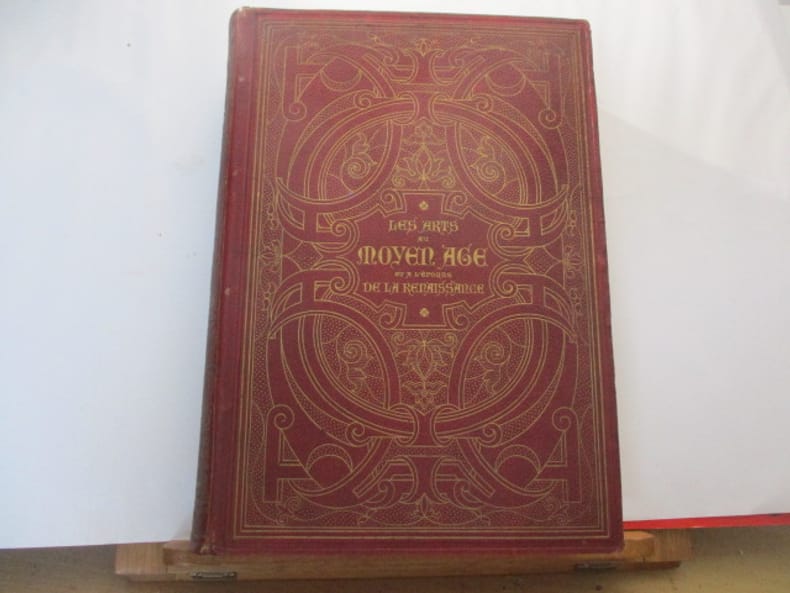
|
|
|
LACHOUQUE Henri Illustrations de Louis de Beaufort. Cartes de Jean-Claude Quennevat.
Waterloo. 1815.
Couverture souple. Broché. 204 pages. 26 x 28 cm.
Riferimento per il libraio : 142887

|
|
|
LACROIX Paul, Conservateur de la Bibliothèque National de l'Arsenal - (Pseudonyme "Bibliophile Jacob") .
LES ARTS AU MOYEN-AGE ET A L'EPOQUE DE LA RENAISSANCE
PARIS, Firmin-Didot Frères, Fils & Cie - 1869 - Grand In-4° - Reliure polychrome ornée de l'éditeur -(frottée) Dos lisse orné de caissons ornés - Toutes tranches dorées - Ouvrage illustré de 19 planches chromolithographiques exécutées par F. KELLERHOVEN et de 400 gravures sur bois - légères rousseurs - 548 pages - bon exemplaire.
|
|
|
LAFONT (Guillaume) & L'ISLE (Guillaume de).
[NARBONNE] Carte du diocèse de Narbonne.
Paris, G. de l'Isle, 1704. 460 x 602 mm.
Riferimento per il libraio : LBW-1897
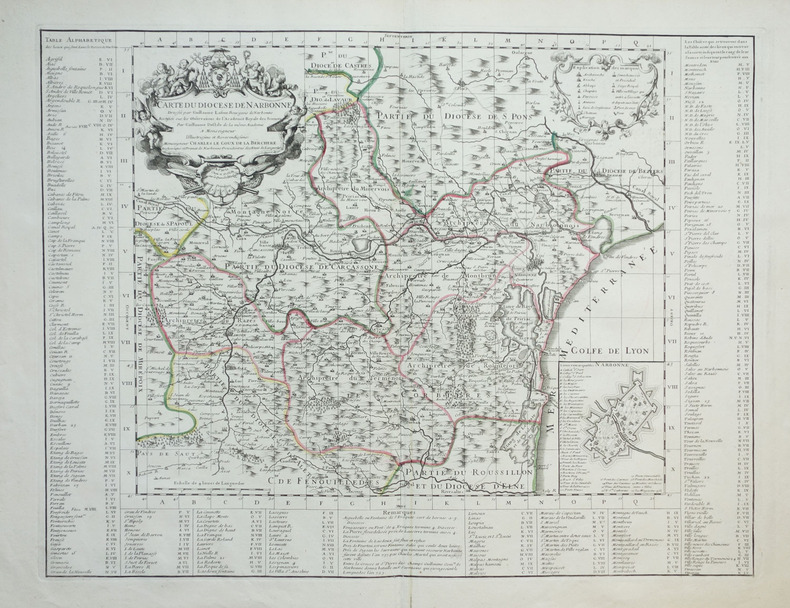
|
|
|
LAFFON Caroline & Martine
Dessiner le monde : histoires de géographie.
Le Grand Livre du Mois, sans date, 187 p., cartonnage sous jaquette oblong, environ 26x30cm, bon état.
Riferimento per il libraio : 105325
|
|
|
LAFRERI Antonio (Orgelet 1512 - Roma 1577)
Rome, Ville tres fameuse…
Rarissima ristampa della lastra anonima - attribuita ad Antonio Lafreri e databile al 1555/60. Esemplare nel terzo stato di quattro descritto e illustrato in Bifolco-Ronca, pagina 2377.In alto a sinistra l’iscrizione Urbis Rome totius olim orbis domitricis, situs: cum adhuc extantibus, sacrosancte vetustatis monumentis PIRRHO LIGORIO NEAP. INVENTOR. Orientazione nei quattro lati al centro con il nome dei punti cardinali SEPTENTRIO, MERIDIES, ORIENS, OCCIDENS, il nord a sinistra.Anonima pianta prospettica della città, basata sulla pianta di Pirro Ligorio, edita da Michele Tramezzini nel 1552. La pianta è inserita in alcuni esemplari dello Speculum Romanae Magnificentiae di Antonio Lafreri, al quale pertanto viene attribuita. Il grande interesse storico di questa pianta non è dato dall’opera stessa, una semplice copia del lavoro del Ligorio, ma è rappresentato dalle tirature successive di questa lastra. Il secondo stato, databile alla seconda metà del XVII secolo, è completamente emendato ed arricchito da toponomastica in lingua francese. Viene inserita anche una lunga descrizione della città, sempre in lingua francese. E’ noto che, alla morte di Antonio Lafreri (1577), i due terzi delle lastre furono divisi tra i nipoti Stefano e Claudio Duchetti. Il restante terzo venne suddiviso tra più editori. Questa lastra quindi potrebbe avere preso la via di Parigi, dove venne ristampata circa un secolo dopo. In alternativa la carta potrebbe essere stampata Roma ed emendata in lingua francese. Tale edizione viene descritta da Hülsen (1915), che la annovera tra le “Copie e ristampe”, come "Incisa nel sec. XVII ex.ovvero XVIII. Ne vidi una copia presso il sig. Lang nel 1914" (la libreria antiquaria Lang di Roma). Un altro esemplare, che tuttavia potrebbe essere lo stesso citato da Hülsen, è descritto nella biblioteca della British School of Rome, appartenuto alla celebre collezione di Thomas Ashby (1874-1931), direttore dell’accademia dal 1906 al 1925. Sempre Hülsen cataloga lo stato finale dell’opera, con l’indirizzo dell’editore francese Francois Jollain. Acquaforte e bulino, stampata su carta vergata coeva, in ottimo stato di conservazione. Bibliografia Bifolco-Ronca, Cartografia e topografia italiana del XVI secolo (2018): pp. 2376-77, tav. 1123, III/IV; Frutaz (1962): n. XVI e tav. 25; Hülsen (1915): II, p. 42, n. 11 e p. 43, nn. 13-14; Karrow (1993): n. 51/1.1; Marigliani (2007): n. 36; Marigliani (2016): n. XI.5. A very rare map of the city, published in Paris in the mid-seventeenth century using the plate made in Rome by Antonio Lafreri.Example of the third state of four.The map is based on that of Pirro Ligorio, 1552, edited by Michele Tramezini in Rome, and its subsequent and numerous variants.The only example known today of this map is in the library of the British School of Rome, belonged to the famous collection of Thomas Ashby (1874-1931), director of the British School at Rome from 1906 to 1925.For the stile of type this work can be attributed to the French publisher Francois Jollain. The plate appears to be yet more ancient, even '500, to which were added numerous inscriptions in French, starting from the extensive description in the bottom right corner.Copper engraving, perfect condition. An extremely rare work.LiteratureBifolco-Ronca, Cartografia e topografia italiana del XVI secolo (2018): pp. 2376-77, tav. 1123, III/IV;Frutaz (1962): n. XVI e tav. 25; Hülsen (1915): II, p. 42, n. 11 e p. 43, nn. 13-14; Karrow (1993): n. 51/1.1; Marigliani (2007): n. 36; Marigliani (2016): n. XI.5. Frutaz (1962): n. XVI e tav. 25; Hülsen (1915): II, p. 42, n. 11 e p. 43, nn. 13-14; Karrow (1993): n. 51/1.1; Marigliani (2007): n. 36; Marigliani (2016): n. XI.5. DI ROMA DAL 1551 AL 1748, (1915) 43e.

|
|
|
LAFRERI Antonio (Orgelet 1512 - Roma 1577)
Urbis Rome, totius olim orbis dominitricis, situs: cum adhuit extantibus, sacrosancte…
Rarissima ristampa della lastra anonima - attribuita ad Antonio Lafreri, databile al 1555/60. Esemplare nel quarto stato di quattro descritto in Bifolco-Ronca, pagina 2377, con l'indirizzo di Jollain. In alto a sinistra l’iscrizione Urbis Rome totius olim orbis domitricis, situs: cum adhuc extantibus, sacrosancte vetustatis monumentis PIRRHO LIGORIO NEAP. INVENTOR. Orientazione nei quattro lati al centro con il nome dei punti cardinali SEPTENTRIO, MERIDIES, ORIENS, OCCIDENS, il nord a sinistra. Anonima pianta prospettica della città, basata sulla pianta di Pirro Ligorio, edita da Michele Tramezzini nel 1552. La pianta è inserita in alcuni esemplari dello Speculum Romanae Magnificentiae di Antonio Lafreri, al quale, pertanto, viene attribuita. Il grande interesse storico di questa pianta non è dato dall’opera stessa, una semplice copia del lavoro del Ligorio, ma è rappresentato dalle tirature successive di questa lastra. Il secondo stato, databile alla seconda metà del XVII secolo, è completamente emendato ed arricchito da toponomastica in lingua francese. Viene inserita anche una lunga descrizione della città, sempre in lingua francese. Alla morte di Antonio Lafreri (1577), i due terzi delle lastre furono divisi tra i nipoti Stefano e Claudio Duchetti. Il restante terzo venne suddiviso tra più editori. Questa lastra, quindi, potrebbe avere preso la via di Parigi, dove venne ristampata circa un secolo dopo. In alternativa, la carta potrebbe essere stampata Roma ed emendata in lingua francese. Tale edizione viene descritta da Hülsen (1915), che la annovera tra le “Copie e ristampe”, come "Incisa nel sec. XVII ex.ovvero XVIII. Ne vidi una copia presso il sig. Lang nel 1914" (la libreria antiquaria Lang di Roma). Un altro esemplare, che tuttavia potrebbe essere lo stesso citato da Hülsen, è descritto nella biblioteca della British School of Rome, appartenuto alla celebre collezione di Thomas Ashby (1874-1931), direttore dell’accademia dal 1906 al 1925. Sempre Hülsen cataloga lo stato finale dell’opera, con l’indirizzo dell’editore francese Francois Jollain. L’opera appartiene allo Speculum Romanae Magnificentiae, la prima iconografia della Roma antica. Lo Speculum ebbe origine nelle attività editoriali di Antonio Salamanca e Antonio Lafreri (Lafrery). Durante la loro carriera editoriale romana, i due editori - che hanno lavorato insieme tra il 1553 e il 1563 - hanno avviato la produzione di stampe di architettura, statuaria e vedutistica della città legate alla Roma antica e moderna. Le stampe potevano essere acquistate individualmente da turisti e collezionisti, ma venivano anche acquistate in gruppi più grandi che erano spesso legati insieme in un album. Nel 1573, Lafreri commissionò a questo scopo un frontespizio, dove compare per la prima volta il titolo Speculum Romanae Magnificentiae. Alla morte di Lafreri, due terzi delle lastre di rame esistenti andarono alla famiglia Duchetti (Claudio e Stefano), mentre un altro terzo fu distribuito tra diversi editori. Claudio Duchetti continuò l’attività editoriale, implementando le lastre dello Speculum con copie di quelle “perdute” nella divisione ereditaria, che fece incidere al milanese Amborgio Brambilla. Alla morte di Claudio (1585) le lastre furono cedute – dopo un breve periodo di pubblicazione degli eredi, in particolare nella figura di Giacomo Gherardi - a Giovanni Orlandi, che nel 1614 vendette la sua tipografia al fiammingo Hendrick van Schoel. Stefano Duchetti, al contrario, cedette le proprie matrici all’editore Paolo Graziani, che si associò con Pietro de Nobili; il fondo confluì nella tipografia De Rossi passando per le mani di editori come Marcello Clodio, Claudio Arbotti e Giovan Battista de Cavalleris. Il restante terzo di matrici della divisione Lafreri fu suddiviso e scisso tra diversi editori, in parte anche francesi: curioso vedere come alcune tavole vengano ristampate a Parigi da Francois Jollain alla m... A very rare map of the city, published in Paris in the mid-seventeenth century using the plate made in Rome by Antonio Lafreri. Example of the fourth state of four, with the Jollain's imprint. The map is based on that of Pirro Ligorio, 1552, edited by Michele Tramezini in Rome, and its subsequent and numerous variants. In the upper left the inscription Urbis Rome totius olim orbis domitricis, situs: cum adhuc extantibus, sacrosancte vetustatis monumentis PIRRHO LIGORIO NEAP. INVENTOR. Orientation in the four sides to the center with the name of the cardinal points SEPTENTRIO, MERIDIES, ORIENS, OCCIDENS, the north on the left. Anonymous map of the city, based on the work byPirro Ligorio, published by Michele Tramezzini in 1552. The ma is inserted in some of the Speculum Romanae Magnificentiae of Antonio Lafreri, to which therefore it is attributed. The great historical interest of this map is not given by the work itself, a simple copy of Ligorio's work, but is represented by the subsequent issues of this plate. The second state, datable to the second half of the seventeenth century, is completely amended and enriched by toponymy in French. A long description of the city is also included, again in French. It is known that, at the death of Antonio Lafreri (1577), two thirds of the plates were divided between his nephews Stefano and Claudio Duchetti. The remaining third was divided among several publishers. This plate therefore may have taken the road to Paris, where it was reprinted about a century later. This edition is described by Hülsen (1915), who lists it among the "Copies and reprints", as "Engraved in the seventeenth century ex.ovvero XVIII. According with Bifolco-Ronca this is the final state of the work, with the address of the French publisher Francois Jollain. The work belongs to the Speculum Romanae Magnificentiae, the earliest iconography of ancient Rome. The Speculum originated in the publishing activities of Antonio Salamanca and Antonio Lafreri (Lafrery). During their Roman publishing careers, the two editors-who worked together between 1553 and 1563-started the production of prints of architecture, statuary, and city views related to ancient and modern Rome. The prints could be purchased individually by tourists and collectors, but they were also purchased in larger groups that were often bound together in an album. In 1573, Lafreri commissioned a frontispiece for this purpose, where the title Speculum Romanae Magnificentiae appears for the first time. Upon Lafreri's death, two-thirds of the existing copperplates went to the Duchetti family (Claudio and Stefano), while another third was distributed among several publishers. Claudio Duchetti continued the publishing activity, implementing the Speculum plates with copies of those "lost" in the hereditary division, which he had engraved by the Milanese Amborgio Brambilla. Upon Claudio's death (1585) the plates were sold - after a brief period of publication by the heirs, particularly in the figure of Giacomo Gherardi - to Giovanni Orlandi, who in 1614 sold his printing house to the Flemish publisher Hendrick van Schoel. Stefano Duchetti, on the other hand, sold his own plates to the publisher Paolo Graziani, who partnered with Pietro de Nobili; the stock flowed into the De Rossi typography passing through the hands of publishers such as Marcello Clodio, Claudio Arbotti and Giovan Battista de Cavalleris. The remaining third of plates in the Lafreri division was divided and split among different publishers, some of them French: curious to see how some plates were reprinted in Paris by Francois Jollain in the mid-17th century. Different way had some plates printed by Antonio Salamanca in his early period; through his son Francesco, they goes to Nicolas van Aelst's. Other editors who contributed to the Speculum were the brothers Michele and Francesco Tramezzino (authors of numerous plates that flowed in part to the Lafreri printing house), Tommaso Barlacchi,...

|
|
|